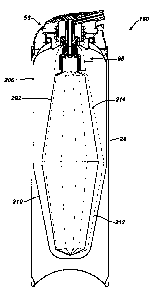Some of the information on this Web page has been provided by external sources. The Government of Canada is not responsible for the accuracy, reliability or currency of the information supplied by external sources. Users wishing to rely upon this information should consult directly with the source of the information. Content provided by external sources is not subject to official languages, privacy and accessibility requirements.
Any discrepancies in the text and image of the Claims and Abstract are due to differing posting times. Text of the Claims and Abstract are posted:
| (12) Patent: | (11) CA 2589078 |
|---|---|
| (54) English Title: | DISPENSING PERSONAL CARE PRODUCTS |
| (54) French Title: | SYSTEME DISTRIBUTEUR DE PRODUITS D'HYGIENE PERSONNELLE |
| Status: | Granted and Issued |
| (51) International Patent Classification (IPC): |
|
|---|---|
| (72) Inventors : |
|
| (73) Owners : |
|
| (71) Applicants : |
|
| (74) Agent: | GOWLING WLG (CANADA) LLP |
| (74) Associate agent: | |
| (45) Issued: | 2011-05-10 |
| (86) PCT Filing Date: | 2005-12-07 |
| (87) Open to Public Inspection: | 2006-06-22 |
| Examination requested: | 2007-05-31 |
| Availability of licence: | N/A |
| Dedicated to the Public: | N/A |
| (25) Language of filing: | English |
| Patent Cooperation Treaty (PCT): | Yes |
|---|---|
| (86) PCT Filing Number: | PCT/US2005/044125 |
| (87) International Publication Number: | WO 2006065586 |
| (85) National Entry: | 2007-05-31 |
| (30) Application Priority Data: | ||||||
|---|---|---|---|---|---|---|
|
A dispensing system comprising: a pressurized canister (24) having top
defining an opening, a bottom, and a generally cylindrical side wall, a
flexible bag (10), disposed within the canister (24), containing a component
to be dispensed from the dispensing system, a valve assembly, in fluid
communication with the bag (10), sealing the opening of the canister (24) and
including a valve defining an outlet through which the component can exit the
dispensing system, and an actuator, configured to open the valve in response
to actuation by a user, wherein the bag (10) includes an upper portion (12)
and a tapered lower portion (14), the lower portion (14) having a sidewall
that tapers away from the side wall of the canister (24) as the bag (10)
approaches the bottom of the canister (24).
L~invention concerne un système distributeur, comprenant un récipient sous pression (24) comprenant un haut définissant une ouverture, un fond et une paroi latérale généralement cylindrique, une poche souple (10), disposée à l~intérieur du récipient (24), contenant un composant à distribuer du système distributeur, un ensemble de valve, en communication fluide avec la poche (10), obturant de façon étanche l~ouverture du récipient (24) et comportant une valve définissant une sortie par laquelle le composant peut s~échapper du système distributeur, et un actionneur, configuré pour ouvrir la valve lorsqu~il est actionné par un utilisateur. Le système distributeur est caractérisé en ce que la poche (10) comporte une partie supérieure (12) et une partie inférieure rétrécie (14), la partie inférieure (14) présentant une paroi latérale qui se rétrécit en s~écartant de la paroi latérale du récipient (24) à mesure que la poche (10) s~approche du fond du récipient (24).
Note: Claims are shown in the official language in which they were submitted.
Note: Descriptions are shown in the official language in which they were submitted.

2024-08-01:As part of the Next Generation Patents (NGP) transition, the Canadian Patents Database (CPD) now contains a more detailed Event History, which replicates the Event Log of our new back-office solution.
Please note that "Inactive:" events refers to events no longer in use in our new back-office solution.
For a clearer understanding of the status of the application/patent presented on this page, the site Disclaimer , as well as the definitions for Patent , Event History , Maintenance Fee and Payment History should be consulted.
| Description | Date |
|---|---|
| Common Representative Appointed | 2019-10-30 |
| Common Representative Appointed | 2019-10-30 |
| Change of Address or Method of Correspondence Request Received | 2018-01-10 |
| Grant by Issuance | 2011-05-10 |
| Inactive: Cover page published | 2011-05-09 |
| Inactive: Final fee received | 2011-02-25 |
| Pre-grant | 2011-02-25 |
| Notice of Allowance is Issued | 2011-02-08 |
| Letter Sent | 2011-02-08 |
| Notice of Allowance is Issued | 2011-02-08 |
| Inactive: Approved for allowance (AFA) | 2011-01-28 |
| Inactive: Adhoc Request Documented | 2010-10-19 |
| Inactive: Delete abandonment | 2010-10-19 |
| Inactive: Abandoned - No reply to s.30(2) Rules requisition | 2010-07-26 |
| Amendment Received - Voluntary Amendment | 2010-07-13 |
| Inactive: S.30(2) Rules - Examiner requisition | 2010-01-26 |
| Amendment Received - Voluntary Amendment | 2009-09-23 |
| Inactive: S.30(2) Rules - Examiner requisition | 2009-03-25 |
| Inactive: Cover page published | 2007-08-21 |
| Letter Sent | 2007-08-17 |
| Letter Sent | 2007-08-17 |
| Inactive: Acknowledgment of national entry - RFE | 2007-08-17 |
| Inactive: First IPC assigned | 2007-06-20 |
| Application Received - PCT | 2007-06-19 |
| National Entry Requirements Determined Compliant | 2007-05-31 |
| Request for Examination Requirements Determined Compliant | 2007-05-31 |
| All Requirements for Examination Determined Compliant | 2007-05-31 |
| Application Published (Open to Public Inspection) | 2006-06-22 |
There is no abandonment history.
The last payment was received on 2010-11-19
Note : If the full payment has not been received on or before the date indicated, a further fee may be required which may be one of the following
Please refer to the CIPO Patent Fees web page to see all current fee amounts.
Note: Records showing the ownership history in alphabetical order.
| Current Owners on Record |
|---|
| THE GILLETTE COMPANY |
| Past Owners on Record |
|---|
| JAMES L. SALEMME |